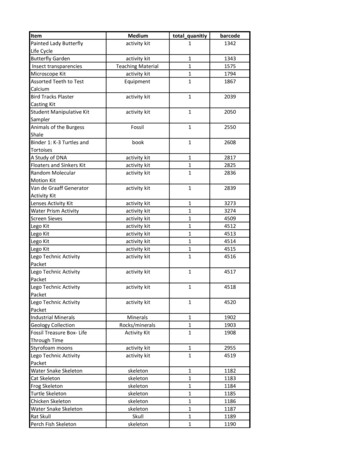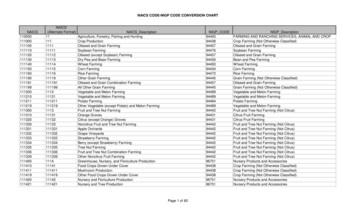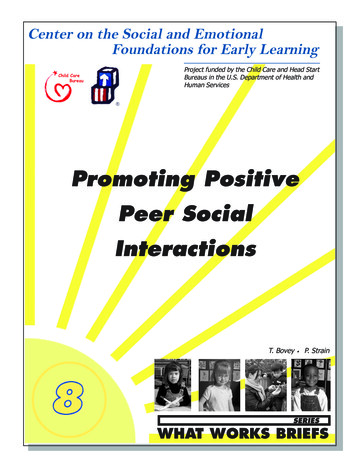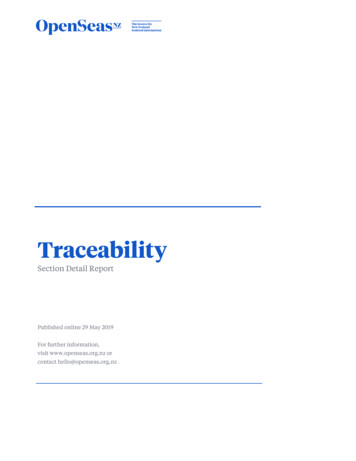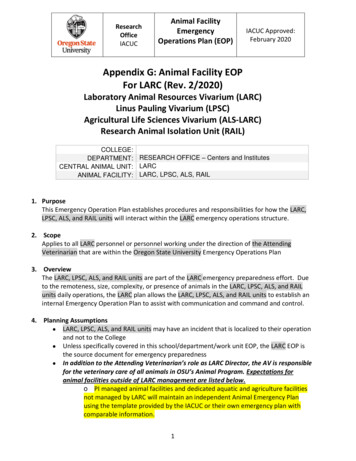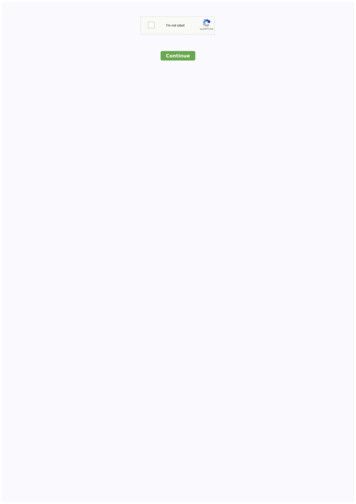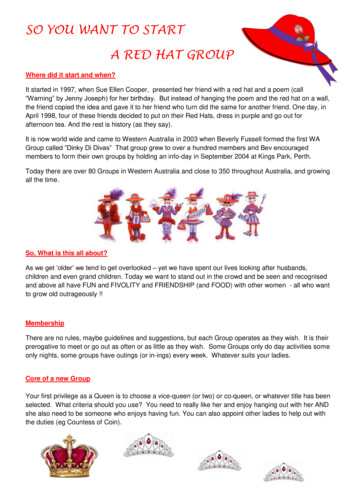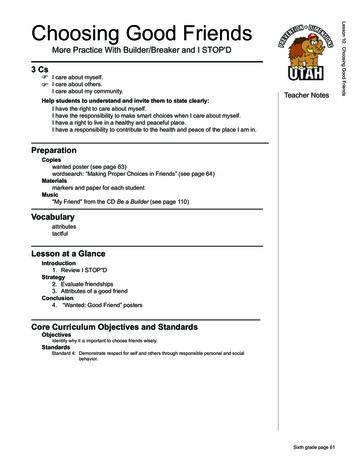
Transcription
Grant ID: 1695Title of Proposal:Agency Type:Total Funding Requested:Check Payable To:Low Income Spay/NetuerNon-Profit 25,000.00SPCA FloridaApplication InformationDemographicsName of Applicant Agency:SPCA FloridaWebsitewww.spcaflorida.orgAddress:Person Submitting Proposal:Adam StanfieldPosition: Executive DirectorPerson Submitting ProposalEmail Address:astanfield@spcaflorida.orgAgency Head:Adam .orgOrganization Business Address:State:5850 Branner Road S.FloridaCity:Zip:Lakeland33813Phone 3-646-4605Agency DetailsDate of 501(c)(3)Incorporation:06/06/1980Dates of Last Fiscal Year:Begin: 01/01/16Organization Income in LastFiscal Year:Organization Expenses in LastFiscal Year:End: 12/31/16 5,110,246.00 6,100,335.00Number of Paid Employees:Full Time: 85 Part Time: 0Number of Active Volunteers:400Total Volunteer Hours per519.00Week:How did you learn of the 2009Florida Animal Friend grantSPCA Florida is a previous grantee of Florida Animal Friends.competition?Year(s) of previous FloridaAnimal Friend grants (if
applicable):Previous Florida Animal FriendYears Funded: 2011 and 2015 Year(s) d (PreviousApplications):ProposalYearProposal TitleStatus1082009Florida Animal Friend GrantProposalDenied1822010Feral Cat Round UpDenied (notcompleted)3542013Community CatsFunded14662015Spay/Neuter of Low-IncomeResidentsFunded1594200616952017Describe your Organization:Services ProvidedDeniedLow Income Spay/NetuerFundedOrganization Structure:City, county, or tribal agencyPrivate nonprofit agencyTNR GroupRescue GroupOtherOpen Admission Intake ShelterLimited Intake ShelterFoster NetworkAnimal ControlSpay/Neuter ServicesOther Full service Vet HospitalList your current board of directors:NameTitlePhoneOccupationBarbara WeberBoard Member 407-938-2823 Disney SupervisorBrenda JoyceBoard Member 863-701-3098 RetiredDawn DiazBoard Member 817-829-8655 Business OwnerJohn MihalyoBoard Member 863-802-7300 Print MediaJulie DavisPresidentKaren MitchellPresident Elect 813-966-2662 RetiredKim GoldenerVice President863-834-6592 City GovernmentLaura LearTreasurer863-688-3440 Financial AdvisorLiz PiotorwskiPast President863-602-9256 RetiredMarion SmithBoard Member 813-754-3707 RetiredMarty WilkeyBoard Members 863-687-6600 Banking VPMary StephensBoard Member 863-646-6403 RetiredPete PalmerBoard Member 863-607-9994 Retired863-701-7834 CPARamona Blankinship Board Member 863-687-7737 AttorneyRick JohnsonBoard Member 863-978-7705 City ManagerSara OlsonBoard Member 863-738-2257 Director Major Gifts
Stacy WalshSecretary863-688-3440 Non-Porfit DevelopmentApplicant QualificationsFor your organization, in the last complete fiscal year:2187 cats and 2056 dogs were admitted.1890 cats and 1894 dogs were adopted.104 cats and 40 dogs were euthanized.4982 cats and 2692 dogs were sterilized.Briefly describe your animal programs:Stray/Lost petFosterintakeProgramOwner surrenderedFood BankanimalsLost and FoundBehaviorProgramcounselingDisasterAdoption ProgramservicesWellness services to understandpet ownersCruelty investigationEnforcement of ordinancesVolunteer ProgramHigh volumespay/neuter clinicFull service welnessclinicIf your program performs adoptions, are all animals sterilized before adoption?YesIf not all, what percentage of animals are not currently sterilized before adoption?N/AIf not all, how are animals selected for sterilization before adoption?N/AIf not all, describe your sterilization policies and procedures for assuring sterilization after adoption:N/AGive additional background information on your organization's programs as they relate to thisapplication and the qualifications of the personnel who will be in charge of this program. Show that youhave the ability to carry out this program.SPCA Florida (SPCAF) is a high functioning medical center working in tandem with a high functioningadoption center to serve the demand of Florida’s third largest county. At the core of our mission is topositively impact animal overpopulation (reduction thereof) through the provision of high-quality, affordablespay/neuter services. SPCAF conducts approximately 50,000 patient visits on an annual basis, comprised ofseeing approximately 27,000 animals. Accomplishing these amazing results is a team of eight highly-skilledveterinarians utilizing state-of-the art equipment and technologies to provide quality care to our patients andclients. In 2016, SPCAF altered more than 7,600 animals. This represented a decline in volume spay/neuterservices over a record high in 2014 of 13,577 procedures. This reduction was purposeful as SPCAF continuedits efforts in the promotion of quality care with emphasis on obtaining AAHA accreditation. Althoughadmirable, our results of 2014 were not sustainable within our defined operating model. Therefore, 2015began a period of transition for SPCAF which was carried through current calendar year. The results of ourefforts in 2016 to provide better organization and procedures established a new operational foundation fromwhich our staff can more confidently and better serve all of our constituents. Our leadership team touredLakeland Regional Medical Center’s Emergency Room to learn from their metamorphosis of a struggling ERto a highly efficient medical facility that dramatically improved its patient throughput and quality of care.From that tour, our leadership team gathered valuable insight and information to increase our own operationalstandards, patient accommodation, and quality of care. The experience gained resulted in our leadership team
implementing efficiency improvements designed to reduce barriers to patient care and throughput. The netresult of our actions will support sustainable and incremental growth in services without a reduction to patientcare standards. We believe this is paramount, irrespective to patient type - be it owned pets, shelter pets,community cats, or feral cats. We have recently added an experienced practice manager to support ourmedical team who, as part of her responsibilities, will work closely with Dr. Alex Cole, Lead Surgeon, and histeam of technicians addressing surgery prep, surgery, and recovery. With more than twelve years’ experienceand a certification as a licensed veterinarian technician, the talents of our new practice manager will continueour progression to setting the highest standards of care within our market. Our community is responding toSPCAF’s paradigm shift with awe and enthusiasm. The pride to which we now invite the public to tour ourfacility is contagious. Seeing the results of our talented staff first-hand has resulted in philanthropic givingexceeding 900,000 during our current fiscal year. We anticipate this trend to continue as well as gainingsupport from our funding agencies. Our intent is to diversify our funding model in seeking an equitablebalance of sources to sustain our operations, including that of our low-income spay/neuter program. SPCAFlorida, Inc. (“SPCAF”), a Florida 501(c) 3 non-profit organization headquartered in Lakeland, exists toeliminate animal suffering and to enhance the human-animal bond by engaging the entire community in thewelfare and well-being of animals. We accomplish this by advancing model programs to promote theadoption of healthy animals, prevent dog and cat overpopulation, provide veterinary medical services foranimals in the community and keep animals in homes through relinquishment intervention strategies. Overthe course of 37 years, SPCAF has effected positive change to the welfare of animals within Polk Countyand surrounding areas. We emphasize spaying and neutering to address pet overpopulation and educate thepublic in responsible animal guardianship. With that animal welfare leadership position in place, now is thetime for SPCAF to focus its energy and resources on the development and expansion of programs that willinspire the compassion and respect for animals necessary to create truly humane communities. SPCAF willcontinue as the premier animal welfare organization throughout the local community and will pursue thatstatus both regionally and state-wide. Offering high-functioning veterinary and adoption services emphasizingquality of care and service, both on campus and through mobile outlets, SPCAF will become the model towhich all sister organizations aspire. Veterinary service growth plans will mimic developments found inhuman healthcare with emphasis on making specialty services available to all clients. The ability to routinelyprovide advanced procedures to shelter animals will further differentiate SPCAF from other rescueorganizations. Growth will include expansion of orthopedic and advanced surgical procedures, dentalservices, and cancer programming. To provide the highest quality of care within the industry, SPCAF ispursuing the American Animal Hospital Association’s (AAHA) accreditation for its medical center andadoption center. Once achieved, SPCAF will be the first comprehensive AAHA-accredited facility in the stateof Florida. Offering a multi-faceted animal welfare and veterinary organization to the community has createdchallenges and, in some cases, misunderstanding of what we do and the services we provide. SPCAF createssignificant economic impact within the region and should use its Board of Directors, staff and volunteers toengage government representatives, community leaders and other influential individuals to address animalwelfare issues in support of our mission.If you currently have a program for sterilization of cats and/or dogs, describe your current level offunding and productivity and why additional resources are needed?SPCAF is Polk County’s largest non-profit spay/neuter provider created to serve pets having owners who areeconomically challenged. With approximately one-fifth of the county’s 600,000 residents living belowpoverty standards, the need for supplementing pet health care is dramatic. The subsidized cost to sterilize catsis approximately 65 and the subsidized cost to sterilize dogs is between 90 and 145. Families meetingcertain needs-based income requirements are eligible for 25 co-pays for cats and 50 co-pays for dogs.Statistically, the large number of clients utilizing the needs-based services is extreme. Polk County AnimalServices (PCAS), a municipal operation, contends with more than 20,000 stray and unwanted animals peryear. We believe in order to adequately reduce unwanted litters throughout our community, we must continueto incent lower socio-economic pet owners to be responsible in providing care for their pet and playing abeneficial role in reducing Polk County’s plight of pet over-population.Target PopulationGeographical target area (name of city, county, zip codes, geographicalPolk County
Information service (GIS), etc.):Total human population in target area:650092Percent of residents living below poverty in target area:Estimated number of pet cats in target area (human population divided by3.3):Estimated number of pet dogs in target area (human population divided by4.0):17.3Estimated number of feral cats in target area (human population divided by6.0):Number of cats admitted to animal control shelters in the target area last year(if known)Number of dogs admitted to animal control shelters in the target area lastyear (if known)Number of cats euthanized in animal control shelters in the target area lastyear (if known)Number of dogs euthanized in animal control shelters in the target area lastyear (if known)196998162523108349N/AN/AN/AN/APlease explain if you believe your target area animal population is significantly different than above.We believe this is an accurate representation of Polk County and target area.Please explain what you believe are the most substantial sources of dog and cat overpopulation in the targetarea:SPCAF believes the most substantial sources of dog and cat overpopulation in Polk County pertain toresponsible pet ownership, education, and economics. From an educational perspective, approximately onefifth of the county’s population lives in poverty which is closely correlated to educational attainment andincome levels. Further, the National Pet Owners Survey conducted by the American Pet Products Associationfor 2015–2016 illustrates approximately 65% of the U.S. population or 79.7 million households own pets – allthings being equal equates to approximately 390,000 households in Polk County. The combination of lowersocio-economic challenges along with the demands of pet ownership creates an unenviable situation for allparticipants. As a catalyst to help circumvent a downward spiral of unwanted litters, the spaying and neuteringof animals is the most humane and cost-effective form of animal control. Polk County is the third largestCounty in Florida and has an overall poverty level just shy of 20%, almost 9 percentage points above the stateaverage of 11.1%. SPCAF’s spay-neuter-vaccinate program provides an affordable option to low income,qualified clients seeking to do the right thing in deterring unwanted litters. Pet owners must prove incomeeligibility to qualify for SPCAF’s low income pet sterilization and vaccination program. The low incomesterilization program markets specifically to a population that may otherwise defer responsible pet ownershipactions for the sake of basic sustenance decisions pertaining to their family.What kinds of spay/neuter services are currently available in the target area and in what ways are theseresources currently insufficient to meet community needs?Currently there are a multitude of for-profit veterinary clinics operating in Polk County. Surveys of pricing forspay/neuter services among these providers’ yields same service pricing that is, on average, minimally 20%higher than that provided by SPCAF. Further examination illustrates the for-profit providers are less likely toadjust their pricing to meet the financial capacities of a client who is economically challenged. In manyinstances quite simply, the client is referred to SPCAF as a last attempt to do what is right by the animal andpreventing unwanted litters.
Florida Animal Friend is highly supportive of proposals that are focused on animal populations that areidentified as substantial sources of dog or cat overpopulation rather than being diluted over too broad ofa geographic area or diverse animal populations. Describe the specific target animal population of thespay/neuter project proposed for this grant:Pets in low-income families Pit Bull / large breed dogsCommunity cats (free-roaming and/or owned) OtherTNR managed colonies of feral catsTNR Managed Colony Feral Cat Program/Community Cats (Free-Roaming and/or Owned) ProgramDefine the precise boundaries of the colony or targeted area, including estimate of square miles.N/AWhat is the criteria used for determining the target area(s) and/or eligibility for this program?N/ADescribe whether the targeted area is rural, suburban, or urban. Is it commercial, residential,agricultural, or a designated special land use?N/AEstimated number of cats in the target colony area : 0Estimated number that are currently sterilized: 0Projected reduction after utilizing the grant: 0For TNR program, describe the ability to maintain lifelong care for remaining cats, commitment level ofvolunteers/organizations, etc.N/ADo current city/county ordinances address TNR or free-roaming cats?NoPlease explain what is allowed:(NOTE: FAF will not fund any program this is inconsistent with local ordinances.)For TNR program, list any groups or government agencies who support this TNR effort:N/ADescribe any effort to lessen the negative impact on local wildlife.N/ADescribe efforts that will be made to mitigate current or potential nuisance issues.N/AWill the cats be ear tipped? YesWill the cats be microchipped? NoProvide any additional information that will help the grant selection committee understand how this program will operate to
achieve its goals.N/AObjectivesWhat do you hope to accomplish with these funds (objectives should be specific and quantifiable)?As per our mission statement, we seek to engage the entire community in the welfare and well-being ofanimals. We believe a dramatic step forward in accomplishing this is to continually push the boundaries ofspay/neuter services to control unwanted litters leading to overpopulation. Therefore, we ultimately areseeking further reduction to the number of unsterilized pets residing in Polk County. The low-incomespay/neuter program goals are: Goal: To humanely reduce the number of homeless unwanted pets in PolkCounty. 1. Behavior Objectives a. Continue expansion of relationships with community leaders and sisterorganizations such as the Polk County Sheriff’s Office, Animal Services Division. We will collaborative workwith them to expand combined efforts while celebrating the successes that are achieved. b. Continuedeveloping model programs to showcase and replicate with other community partners; specifically within newmarkets where existing pet populations are out of control. c. Continue driving responsible pet ownershipeducation opportunities throughout the community and specifically the importance of spaying/neutering pets.2. Performance Objectives a. In one-year, we will alter 1,000 pets belonging to low-income residents of PolkCounty 3. Process Objectives a. We will document the number of dogs and cats by the number of males,females,pregnant females and females in heat in each targeted area. b. We will monitor annual statistics amongSPCAF and PCAS, including total impound/intake numbers, stray impound/intake numbers, euthanasia rates,and adoption rates. c. Evaluate results seeking to determine trends and success of our efforts.How does this program increase the number of sterilization surgeries above the existing baseline?Simply, implementation of this program will allow SPCAF to confidently market such spay/neuter services toan “indigent” population while emphasizing responsible pet ownership. The mere fact SPCAF will marketservices means that each client will incrementally add to the total of procedures over and above our base lineprocedures. As previously mentioned, this economically challenged target population must be incented toproperly accommodate sustenance decisions at the family level.MethodsWhat criteria will you use to determine eligibility for your program?To qualify for SPCAF low-income spay and neuter services for companion animals, pet owners or guardiansmust demonstrate proof of participation in one of the following needs-based public assistance programs:Children’s Health Insurance Plan (CHIP), Major VA Disability, Food Stamps, Medicaid, Social SecurityDisability (SSD), Women, Infants, and Children (WIC), HUD Section 8 Housing, Supplemental SecurityIncome (SSI), Or Temporary Assistance for Needy Families TANF). All documentation, where appropriate,will be scanned into the client file where it will attach to the electronic medical record. This will ensure allsubsequent visits by said client to SCPA Florida are properly addressed.How will you advertise the program? Explain how the advertising will reach the target audience.SPCAF has expansive marketing infrastructure to apply to the communication of operational programmingand services. These media outlets include traditional lines such as mass print, television and radioopportunities. Details of these programs can be found on our website (www.spcaflorida.org). We have alsogenerated significant interest and growth among all social media marketing channels including Facebook(34,000 followers), Twitter (3,000 followers), Instagram (approx 500 followers), and Periscope among others.For 2017, we are actively integrating all media outlets in a coordinating effort to ensure maximum exposure ofSPCAF’s messaging. Additionally, we have an email database in excess of 30,000 emails derived frommultiple sources including our CRM, medical center’s POS – Avimark along with shelter POS – Petpoint. Wewill utilize these contact points by sending periodic promotional emails regarding low cost spay/neuterservices among others. Additionally, we are currently exploring text messaging communications to our clients
with texting capabilities, which includes a large proportion of clients. Last, word of mouth advertising is asignificant tool for communicating among all populations. We will leverage all of the preceding opportunitiesto generate word of mouth momentum throughout Polk County regarding our low-income spay/neuterprogram.How will you address barriers to full use of the program such as transportation, illiteracy, and culturalhurdles?Qualified applicants are required to coordinate their own transportation to and from SPCAF. This may includetheir own vehicles, public transportation, or other newly developed transportation services such as UBER orothers. From a cultural perspective, we have evaluated our staff as to their capabilities and interest to providetranslation services. Polk County’s largest ethnic population is Spanish speaking. Presently we have four staffmembers to serve as Spanish conversationalists. In addition, we have developed marketing collateral that isboth targeted for English and Spanish speaking populations.Does this project involve the transportation of animals by someone other than the client? If so, describethe vehicles, methods for confinement, personnel training, liability releases used to assure the safety ofthe animals and handlers.N/AVeterinary ServicesWhat arrangements have you made with veterinarians to perform the surgeries?Our business model is built on SPCA Florida having nine DVM's FTE's. The majority of our DVM staff willrotate through surgery as needed. If need be, we will solicit the assistance of proven relief DVM's.Are they: In-house Private Vet(s) CombinationVeterinary PracticesPractice NameSPCA FloridaAddress5850 Brannen Road S.CityLakelandStateZipPhoneLead PracticeFlorida 33813 863-646-7722Fee RangeWhat is the fee range to be paid for spay and neuter and what is the distribution to be paid by the client vs. thegrant program? Keep in mind that Florida Animal Friend grant funds may only be used for costs directlyassociated with sterilization surgery (including anesthesia and pain control) and not for other items such asvaccines, testing, licensing, and capital purchases.Range for Male CatsRange for Female CatsRange for Male DogsRange for Female DogsAmount Paid by ClientAmount Paid by Project Total Amount 0.00 0.00 0.00 0.00 25.00 25.00 50.00 50.00 25.00 25.00 50.00 50.00Please check each item below to indicate additional services offered at the time of surgery, whether the clientis required to pay for them, and if so what the fee is. For example, if an examination is required for surgery
but is not charged to the client it would be marked: RequiredRequired, Optional, or NotOfferedRequired Optional NotExaminationAvailableRequired Optional NotRabies Vaccination ifDueAvailableOther Vaccination ifDuePain MedicationParasite MedicationHW TestingFeline Leuk/FIVCounty LicenseEar eOptionalNotOptionalNotYes, Fee to clientNoFee to esNoYesNoYes 14.00 20.00 24.00 25.00None of the anticipated grant funds can be used for any of the above services, except for painmedication.If necessary, please explain the procedures and fees described above:Other fees may include a 25.00 charge for being in heat or pregnant - dog or cat.Is this a voucher program? NoIf so, how will you assure compliance with the program?For your voucher program, how have you determined the capacity of the veterinarians listed above tohandle the projected capacity?Will you have the ability to report the number of vouchers issued and the percentage that result in S/Nsurgeries?Community CollaborationTo assure the success of your program, are there any local groups (such as rescue groups, animal controlagencies, TNR groups, local businesses, local media, social service agencies,etc.) other than your
organization and your cooperating veterinarians who are committed to assist?Yes NoPlease list them and detail their level of involvement with the proposed effort.NameLevel of InvolvementPolk CountyThe Polk County Board of Commissioners support our low-income spay/neuter servicesBoard ofand provided 14,500 to this program in 2015.CommissionersPolk County SPCA Florida and Polk County Animal Services work closely in addressing the collectiveSheriff's Office needs of more than 20,000 homeless animals. SPCA Florida is the largest, private, non, Animalprofit, animal welfare organization that transfers animals from Polk County AnimalControlServices. SPCA Florida will typically transfer between 900 and 1,200 animals per yearServicesfrom Polk County Animal Services.Other InformationProvide any additional information that will help the grant selection committee understand how theprogram will operate to achieve its goals.SPCA Florida has operated and provided spay/neuter services to low-income residents of Polk County for thepast 37 years. We have gained a significant understanding of our community and have established significantrelationships with many government officials, organizations, and individuals since our inception. This gives usthe confidence and capability to successfully reduce the number of unwanted puppies and kittens fromindividuals that otherwise could not support these animals. This funding from Florida Animal Friends wouldbe a great benefit to SPCA Florida in helping us service the community in which we serve.BudgetTotal number of sterilization surgeries projected:Cats: 315 Dogs: 325Total budget requested (Budget should not exceed 25,000): 25,000.00Average cost/surgery projected: 40.00Describe any expenses that are not included in the grant and how they will be paid for (for example,vaccines, microchipping, ear notching, etc.):Rabies vaccines are required for pets not already vaccinated. Rabies vaccines are 14.00 and Countylicensing is included in that price. Other services are available to the client but will not be covered by thisgrant.Describe any other funding sources for this program, i.e. other grants, targeted fundraising efforts,budget allocation, etc.SPCA Florida applies for low-income spay/neuter program support through Polk’ County’s Board ofCounty Commissioners (BOCC) with a varying degree of success. We understand as evidence throughseveral years’ of declining support, the BOCC is interested in phasing out their “outside agency”programming. SPCA Florida will however continue to apply as possible. It is through the BOCC supportand that of Florida Animal Friends SPCA Florida can continue their perpetual spay/neuter effort, as demandfor said services remains consistent and strong. SPCA Florida also continues its general funding raisingefforts through the Guardian Angel program. Monies raised through the Guardian Angel program helpsSPCA Florida cover the cost of free healthcare provided to our “indigent” population, uncompensated care,which routinely exceeds 10,000 - 12,000 per month. Such solicitation efforts include Newsletter and Eblast communications as well as personal asks of individual donors. All monies collected in turn, areallocated through our annual budgetary process.
What percent of the total cost of the program would this projected grant cover?50TimelineAll projects must be completed within 12 months of receipt of funding.Projected start date: 06/01/17/Projected end date: 05/31/18Unexpended fundsAny unexpended funds must be refunded to Florida Animal Friend within 30 days of the end of the project.Requests for extensionsRequests for time extensions are discouraged and not often granted. If it is imperative to request an extension,such request must be made in writing at least 30 days prior to the end of the project. It is FAF’s policy toseldom grant more than a 30-60 day extension.Failure to submit reports and requests within the required time period will impact your agency’s future grantapplications.Future Funding to Sustain Public Spay/Neuter*Explain how the organization plans to fund this program in the future. Having sustainable plansincluding other grants, local donations and other services generating revenue enhances the chances ofreceiving this grant.SPCAF routinely applies for various grants in support of meaningful and impactful mission-oriented services.Such funding however cannot be confidently counted on but is extremely appreciated when received. As suchand as previously indicated, fiscal year 2015 was a year of transition for SPCAF in many respects, financialincluded. Our aim has been to diversify our funding model so we do not disproportionately rely on a singlesource of revenue to sustain our operation. This diversification also relates to grant funding that had grown intoa large portion of our budget. Going forward, we will still apply to our funding partners when and whereappropriate while seeking alternative funding opportunities as well. Specifically, we have developed asolicitation program designed to create mutually beneficial relationships with our financial supporters andbusiness community. The program integrates our vast marketing resources and focuses those capacities on ourfinancial supporters according to their commitment levels. Doing so creates a win/win relationship foreveryone involved either through funding support or business development initiatives supported by acustomized marketing plan created for the individual entity. Events also occupy a proportionate share of ourphilanthropic initiatives. In addition to the new corporate solicitation program above, we continually seekways to grow the effectiveness of our events th
pursuing the American Animal Hospital Association's (AAHA) accreditation for its medical center and adoption center. Once achieved, SPCAF will be the first comprehensive AAHA-accredited facility in the state of Florida. Offering a multi-faceted animal welfare and veterinary or ganization to the community has created

